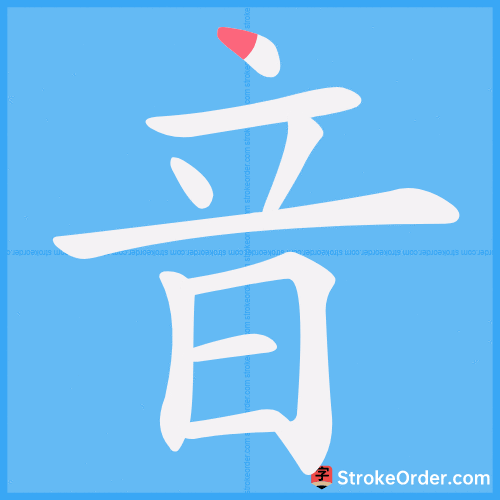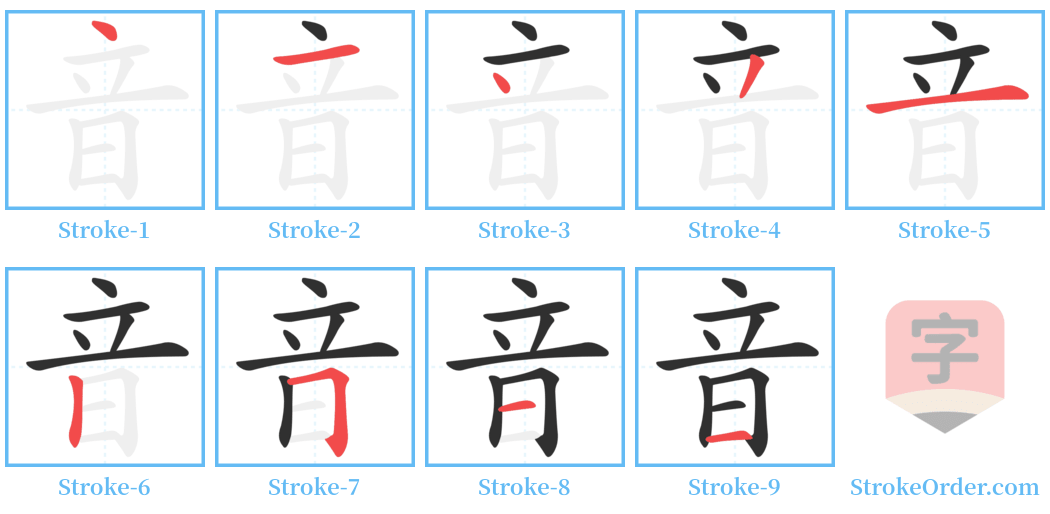音 Stroke Order
Animated Stroke Order of 音

Stroke Order Diagrams for 音

Step-by-Step Handwriting Guide for 音

Learn to Write Chinese Characters with Video Tutorials
Watch the video of writing the Chinese character "音", learn the correct stroke order (笔顺) of the character "音", and master the standard way of writing the character "音".
Free Printable Handwriting Practice with Stroke Order: 音
Printable Writing Practice Worksheet of "音" in Portrait Orientation (Tian Zi Ge)

Printable Writing Practice Worksheet of "音" in Landscape Orientation (Tian Zi Ge)

Information of 音
Pinyin
yīn
Radical
音
Strokes
9 strokes
Usage
★★★★★
Definition
sound / noise / news
音 [yīn]
1. 声,亦特指有节奏的声。
(Sound, also specifically refers to rhythmic sound.)
2. 信息,消息。
(Information, news.)
音 [yīn]
1. 声,亦特指有节奏的声:声~。~乐(yue)。~律。~色。~量。~区。~韵。~像。~容(声音、容貌)。弦外之~。
(Sound, also specifically refers to rhythmic sound: sound of music; musical rhythm; sound color; sound volume; sound range; sound melody; sound image; sound form (sound, appearance). Sound that is outside the string.)
2. 信息,消息:~信。佳~。~讯。
(Information, news: message; good news; news.)
音 [yīn]
(名)
【本义】:声音
(Basic meaning: sound)
【造字法】:指事。从言含一。甲骨文“言、音”互用,金文、小篆在“言中加一横,表示所发之音。
(Character formation method: it indicates an idea. It is formed from the character for speech with an additional stroke to denote the sound produced.)
1. 同本义 ([En.] sound; voice)
(Same as the original meaning: sound; voice)
【引】
1. 《说文》:音,声也。生于心,有节于外。谓之音。
(From "Shuowen": Sound is voice. It arises from the heart and has rhythm externally; it is called sound.)
2. 《白虎通·礼乐》:八音。一说笙、祝、鼓、箫、琴、埙、钟、磬也。
(From "Baihu Tong": The eight sounds. One interpretation includes sheng, zhu, drum, xiao, qin, xun, bell, and qing.)
3. 《礼记·乐记》:凡音之起,由人心生也。声成文,谓之音。
(From "Liji": All sound arises from the human heart. Sound becomes text; it is called sound.)
4. 《左传·昭公二十一年》:夫音,乐之舆也。
(From "Zuo Zhuan": Sound is the vehicle of music.)
5. 《庄子》:鸡狗之音相闻。
(From "Zhuangzi": The sounds of chickens and dogs can be heard together.)
6. 宋·苏轼《石钟山记》:北音清越。
(From Su Shi's "Record of Stone Bell Mountain": The northern sound is clear and far-reaching.)
7. 清·姚鼐《登泰山记》:鸟兽音迹。
(From Yao Nai's "Record of Climbing Mount Tai": Sounds and traces of birds and beasts.)
【例】
又如:音颡(喉咙);音强(指声音的强弱。也叫响度或音势。音的强弱,因发音体振动时之振幅大小而异,振幅大者则音强,振幅小者则音弱);音制(音调高下疾徐的节奏);音频(人类耳朵能产生反应的声音频率范围)
(For example: throat; sound strength (refers to the intensity of sound, also called loudness or sound force); sound rhythm (the pace of sound variations); sound frequency (the range of sound frequencies that can stimulate human ears).)
2. 音乐 ([En.] music tone)
(Music tone)
【引】
1. 《庄子·养生主》:莫不中音。
(From "Zhuangzi": None can be without music.)
2. 《史记·廉颇蔺相如列传》:赵王好音。
(From "Records of the Grand Historian": The king of Zhao loves music.)
3. 如:音律;音调
(Such as: musical scale; musical pitch.)
4. 泛指语言、消息、讯息等 ([En.] news; message; information).
(Generally refers to language, news, messages, and other forms of information.)
【例】
如:佳音;音讯(言信,消息)
(For example: good news; news (messages).)
5. 字的音读 ([En.] pronunciation)
(Pronunciation of characters.)
【引】
1. 唐·贺知章《回乡偶书》:乡音无改。
(From He Zhizhang's "Returning Home": The accent of my hometown remains unchanged.)
2. 宋·王安石《游褒禅山记》:盖音谬也。
(From Wang Anshi's "Record of Striding the Buzhen Mountain": It must be an error in pronunciation.)
【例】
又如:音韵(指“汉”字字音中的声、韵、调)
(For example: phonetics (referring to the tone, rhyme, and pitch in the pronunciation of the character "汉").)
音 [yīn]
(名)
1. 树荫。《左传·文公十七年》:「鹿死不择音,小国之事大国也,德则其人也,不德则其鹿也。」通「荫」。
(Shade of a tree. From "Zuo Zhuan": "When a deer dies, it does not choose its shade; the affairs of a small country concern a large country. If virtuous, it is these people; if not virtuous, it is their deer.")
sound / acoustics / audio / hi-fi system / stereo sound system / abbr. for 組合音響|组合音响[zu3 he2 yin1 xiang3]
Input Method for 音
Pinyin
yin1
Wubi
ujf
Cangjie
yta
Zhengma
suk
Four Corner
00601
Unicode
U+97f3
Same Pronunciation Characters